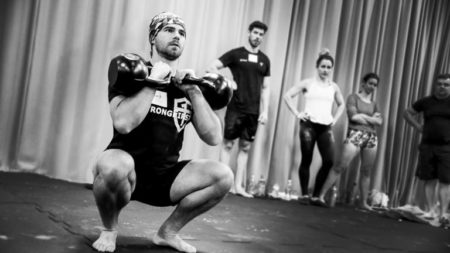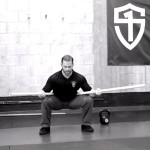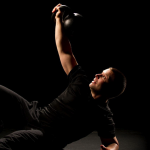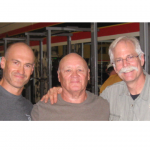Interesting thing about the word troubleshooting (I’ll get to the main point soon…promise) in the context of coaching: when you look for synonyms, you need to wade through synonyms for it in the context of damage control, “good offices,” and customer service before you get to “as in adjust.” And “as in adjust” troubleshooting is probably the most relevant to how we use it in coaching or teaching.
Troubleshooting synonyms in relation to “as in adjust” include: readjust, calibrate, bring into line and sharpen. (See HERE.) All excellent words to frame it in action. When looking at a student’s exercise practice, we are looking to bring their form into line, sharpen the skill, calibrate the skill to the individual, and readjust the technique (if needed).
This is what makes the experience of working with a StrongFirst instructor (whether individually, or at a course or certification) so powerful. Troubleshooting.
Troubleshooting in Action: the Squat
At a recent SFG Level 1 Certification in Italy, during a dedicated troubleshooting segment, a student came up to demonstrate their squat. Now it was up to me to identify the issue and have a way to improve it. (In front of about a hundred people). No pressure.
 An important aspect of troubleshooting from the coach’s perspective is to open the gaze and watch the entire movement. You cannot “run the checklist” of all the “pieces and parts” involved in the skill being evaluated. Step back and watch.
An important aspect of troubleshooting from the coach’s perspective is to open the gaze and watch the entire movement. You cannot “run the checklist” of all the “pieces and parts” involved in the skill being evaluated. Step back and watch.
Two things stood out to me. First, the student was not using the ankles fully in the squat. Second, the student was not creating space during the squat. Very common challenges.
So…now what?
Time to pick a drill to improve the skill. For that, I selected something from my Functional Movement Systems (FMS) “toolbox.” A loaded, rhythmic mobilization, in the half kneeling position—half kneeling pulses. Article HERE.
How to: Half Kneeling Pulses
Begin in a wide-stance tall kneeling posture with the “shins in” at 45-degrees and big toes touching. Step up and out with one leg so it is perpendicular to the down leg/shin. The up leg is at a perpendicular 45-degree angle to the down leg/shin 45-degree angle.
If you “short the step” of the up leg and pulse forward, you will “run into” the ankle of that leg.
If you “extend the step” of the up leg and pulse forward, you will “run into” the adductors and hips of both legs.
Hold a kettlebell with two hands behind you and “push it down” to extend your half-kneeling posture to be as tall as you can. Perform 5 pulses forward with the short step, and 5 pulses forward with the extended step. Return to the tall kneeling posture to reset the 45-degree angles; repeat on the other side. Perform twice on each side.
Key points:
- Maintain a tall posture and do not lean or collapse during the pulse forward.
- Do not allow the front knee to go into valgus collapse—adjust the position of the front foot to prevent this and “push the knee out”.
- Do not go further than you can. In other words, use all 5 pulses to slowly build up the range of motion.
- Do not move into pain. If you feel a pinch and pain in the front of the ankle or hip(s), stop or shorten the range, and consult with a Healthcare Provider.
- Use a mat or padding for the knees.
After having the student perform the drill as described, I had them return to the squat with these cues or tips. 1) Use your ankles. It is ok for your shins to move forward just like the drill you just performed. 2) Open the hips just like you felt in the extended step pulses.
The student’s squat was greatly improved. Two things here: 1) I did not “talk” the student to death. 2) I used a drill to mobilize, control, and bring awareness. The awareness from the drill can then be used in the goal skill.
Do not talk your student to death. - Brett Jones on coaching. Click To TweetGive the drill a try and let us know how it works for you on the StrongFirst forum. This is just a peek inside what it means to learn the StrongFirst principles and techniques and how we integrate information from our partners like FMS. If you would like to learn more, you can attend an event like Foundational Strength. And any of our StrongFirst certifications.
Step back, open your gaze, and watch the entire movement. - Brett Jones on improving a student's form. Click To Tweet
Resources Mentioned
FMS – Functional Movement Systems
Foundational Strength – Event








Hi Brett,
this is a great article, I have never used this particular drill for improving students’ squats. I wanted to try it on myself first before giving it to students, but the trouble is my hips and ankles are really really mobile (I do overhead cossac squats and overhead pistols with my butt actually sitting on the ground at the bottom), but I often need to extra mobilize my hip/ankle on the left side in order to do those. I used this drill for my left side and it felt much more smooth right away. So it seems this drill works for all squat manifestations. Thank you again 🙂
My ankle mobility/dorsiflexion is very limited. Finding someone who can mobilise my ankle joint is expensive trial and error. I have done lots of drills on my ankles to no avail. Very frustrating!
Karen
Where are you located?
Have you had imaging of your ankles and/or evaluation by a medical professional?
(there could be a mechanical reason you lack ankle mobility due to joint structure etc…)
I was just telling myself today that squats are my biggest weakness. So I tend to avoid them… when in fact I should be doing the opposite. I do notice in the lowest position of the squat, I feel a bit of soreness/pain in my inner thigh/hip area. I’m going to try this drill and see if it helps! Thanks!
Excellent – remember to build up range of motion slowly and keep us posted
Best drill ever. Use it with clients all the time.
Excellent
Thank you, Brett! I sprained my ankle as a kid. The first time, it was never treated. Subsequent times, X-rays, ACE bandage, crutches, elevated with ice. You can see it’s not a happy joint, and does not extend or flex as the other one does. It does affect my get-ups, so I’m hoping this will help.
Maria
Go slow and listen to your body (no pain or pinching in the front etc…)
You may want a consult with a Physical therapist skilled in manual therapy to mobilize the ankle.
Keep us posted